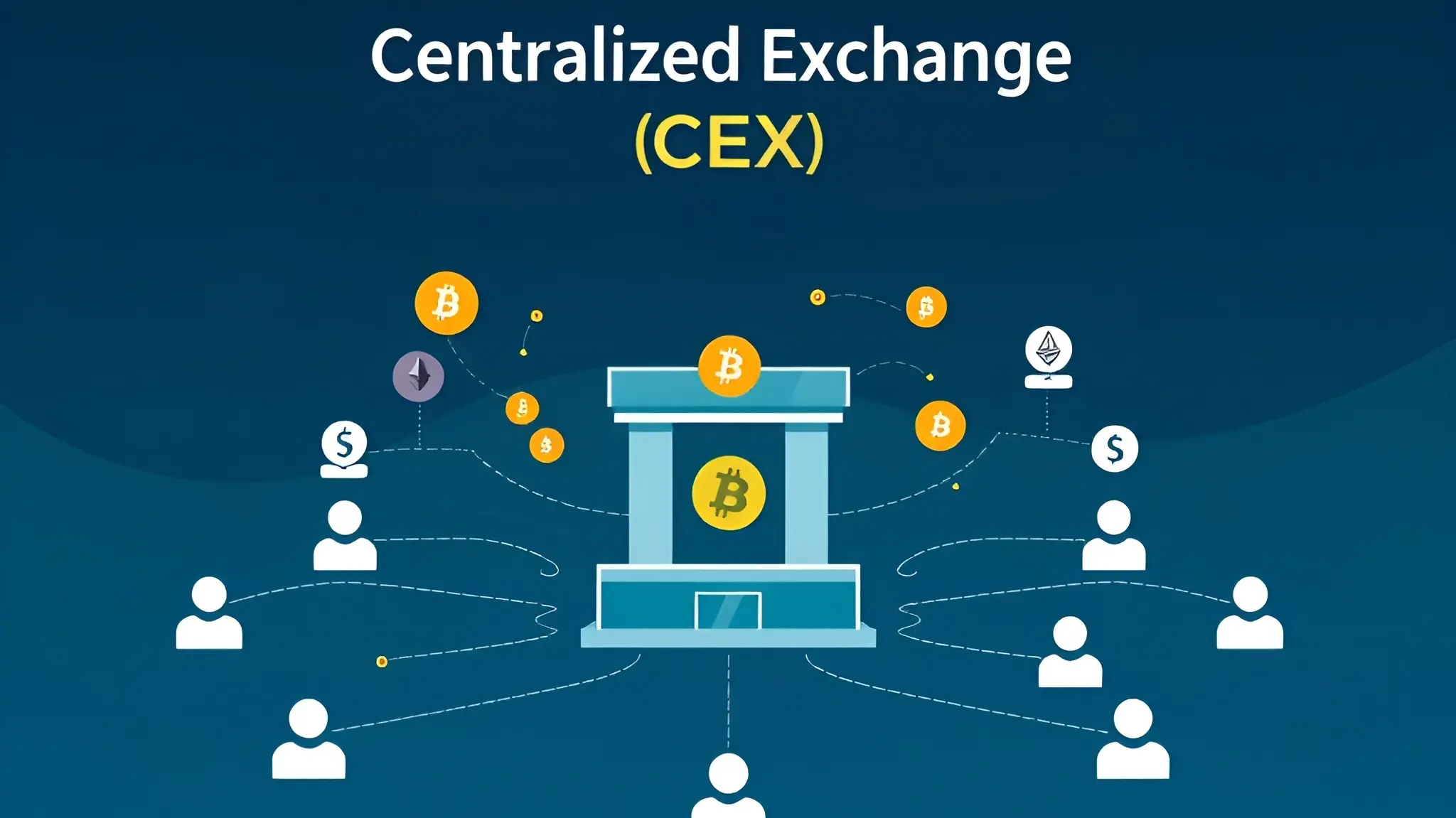What Is a Centralized Exchange (CEX)?
A centralized exchange (CEX) is a digital trading platform that connects buyers and sellers of cryptocurrencies (and sometimes other assets) through a central authority or third-party operator.
These exchanges act as intermediaries, providing liquidity, matching orders, and ensuring secure transactions in a regulated environment.
Traders create accounts to manage their balances and personal data, while the exchange oversees trading operations and order matching using a centralized order book.
Key Takeaways:
ShowDefinition of a Centralized Exchange
A centralized exchange (CEX) is a digital marketplace run by a third-party organization, primarily focused on cryptocurrency trading.
Users sign up for accounts, deposit funds, and entrust the platform to handle transactions, balance tracking, and user data.
By employing robust security protocols—such as two-factor authentication and encryption—CEXs aim to protect assets from unauthorized access.
However, users must be aware that reliance on a central entity introduces certain risks (e.g., hacking or regulatory intervention).
As a result, choosing whether to use a CEX often involves balancing convenience against these potential vulnerabilities.
1. Key Features of CEXs
- High Liquidity: CEXs handle large trading volumes, ensuring quick order execution.
- User-Friendly Interfaces: Simplified dashboards and trading tools
- Advanced Security: Two-factor authentication (2FA), cold storage, and encryption
- Diverse Trading Pairs: Mostly offer a broad selection of cryptocurrencies and pairs
- Regulatory Compliance: Operating within legal frameworks builds
2. Security Considerations
To maintain user confidence and protect assets, CEXs generally adopt multiple security layers:
- Cold Storage: Keeping the majority of assets offline to reduce hacking risks.
- Two-Factor Authentication (2FA): Prompting additional verification steps (e.g., SMS, authentication apps).
- Regular Security Audits: Ongoing assessments to uncover and resolve potential vulnerabilities.
- Insurance Policies: Covering specific losses in case of security breaches or system failures.
How Centralized Exchanges Work

CEXs link buyers and sellers on a platform designed to facilitate secure and efficient trades. The process typically includes:
1. Account Creation
Users register, complete identity verification (KYC), and enable security features.
2. Deposit Funds
Traders deposit cryptocurrency or fiat currency into an exchange-managed wallet.
3. Order Placement
Users set buy or sell orders, which the centralized order book matches with available counterparties.
4. Execution and Settlement
Once matched, trades execute automatically, and assets transfer accordingly, managed by the exchange’s internal systems.
This structure allows for high liquidity and a streamlined user experience.
Advantages and the Disadvantages of CEXs
1. Pros of Centralized Exchange
- Enhanced Security: Most CEXs employ strict measures like encryption and multi-factor authentication.
- High Liquidity: Large user bases and trading volumes reduce price slippage and speed up trades.
- User-Friendly Interfaces: Clear layouts, accessible tools, and customer support accommodate varying skill levels.
- Customer Support: Dedicated teams help users resolve issues related to deposits, withdrawals, or technical problems.
2. Cons of Centralized Exchange
Despite their benefits, CEXs also carry notable drawbacks:
Security Vulnerabilities and Risks
- Centralized Control: A single point of failure can make an exchange an attractive target for cyberattacks.
- Data Breaches: User information stored on exchange servers can be compromised.
- Phishing Attacks: Scammers may imitate the exchange’s website or emails to steal login details.
Limited Control Over Assets
- Custodial Model: Funds are held in the exchange’s wallets, reducing users’ direct control.
- Withdrawal Restrictions: Exchanges may impose minimum or maximum withdrawal amounts and fees.
- Platform Insolvency: If the CEX mismanages funds or declares bankruptcy, user assets can be lost or frozen.
Regulatory Compliance Challenges
- KYC and AML Requirements: Users must submit personal information, which some find burdensome.
- Data Protection Laws: Exchanges expend significant resources to meet varying legal standards.
- Licensing and Registration: Operating in multiple jurisdictions can be costly and complex, influencing token listings and user access.
Popular Centralized Exchanges
Several major CEXs lead the industry with high trade volume, wide coin listings, and strong security measures:
- Binance: Extensive asset selection, advanced trading features, competitive fees.
- Coinbase: Emphasis on regulatory compliance and simplicity, ideal for newcomers.
- Kraken: High-security standards, robust trading options (spot, futures, margin).
- Huobi: Large global presence, numerous altcoins, user-friendly interface.
These exchanges often feature multi-factor authentication, cold storage, and 24/7 customer support to protect user funds and build trust.
Future of Centralized Exchanges

As cryptocurrencies become more mainstream, CEXs will likely evolve in response to user demands and regulatory pressures. We may see:
- Stronger Security Protocols: Advanced encryption and multi-signature technology to further secure user assets.
- Greater Regulatory Coordination: Exchanges striving to comply with laws across multiple regions, boosting legitimacy and user trust.
- Hybrid Services: Inclusion of decentralized finance (DeFi) products, combining CEX efficiency with features found in decentralized platforms.
- Improved User Experience: Seamless onboarding, faster transactions, and more intuitive interfaces.
Balancing these innovations with compliance and user protection will shape the future of centralized exchanges.
Wrapping Up
Centralized exchanges act like bustling crypto marketplaces, offering high liquidity, user-friendly interfaces, and a regulated environment for traders worldwide.
However, their centralized architecture means users trust a single entity to secure their funds and comply with regulations.
Staying informed about potential risks, maintaining good security practices, and monitoring evolving industry trends are essential for anyone through the world of CEXs.
Frequently Asked Questions (FAQs)
What Cryptocurrencies Can I Trade on Centralized Exchanges?
Centralized exchanges usually list popular cryptocurrencies like Bitcoin, Ethereum, and Litecoin, along with numerous altcoins. Always check each exchange’s listings and security measures before trading.
How Do I Create an Account on a CEX?
Register on the exchange’s official website or app, complete the identity verification (KYC) process, and enable two-factor authentication to protect your account.
Are There Withdrawal Limits on Centralized Exchanges?
Yes. CEXs often impose daily or monthly withdrawal limits based on your verification level. These measures help reduce fraud and comply with AML regulations.
What Fees Are Associated With CEXs?
Most centralized exchanges charge trading fees (around 0.1%–0.5%), withdrawal fees, and possibly deposit fees. Review the fee structure before trading to ensure it aligns with your financial strategy.
How Do I Recover a Lost CEX Account?
Contact the exchange’s support team, provide identity documents, and follow their procedures to restore account access. Always safeguard login credentials and recovery information.

